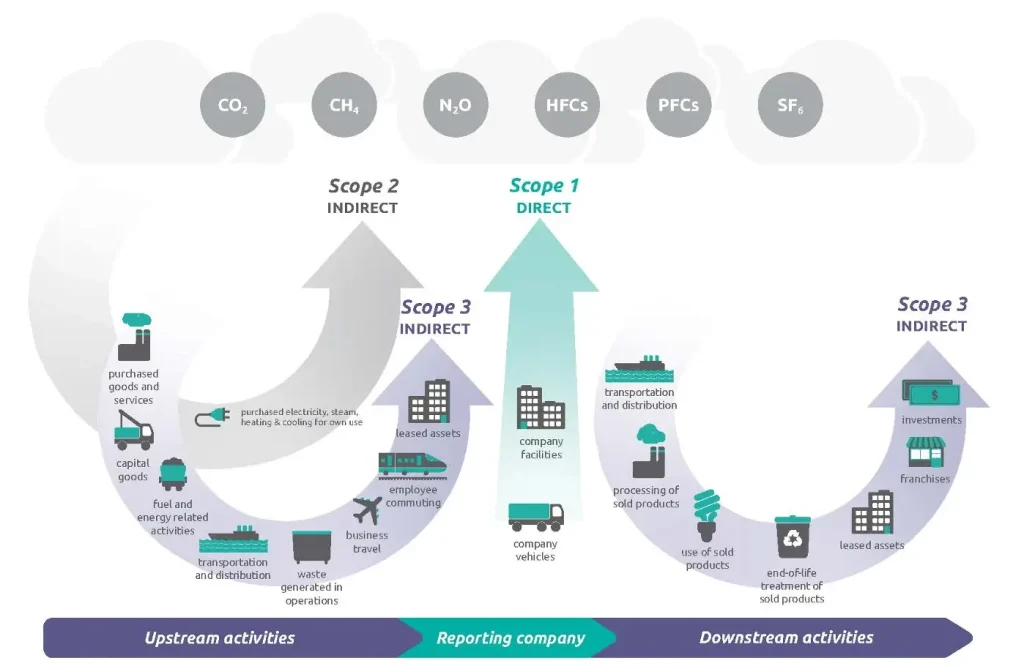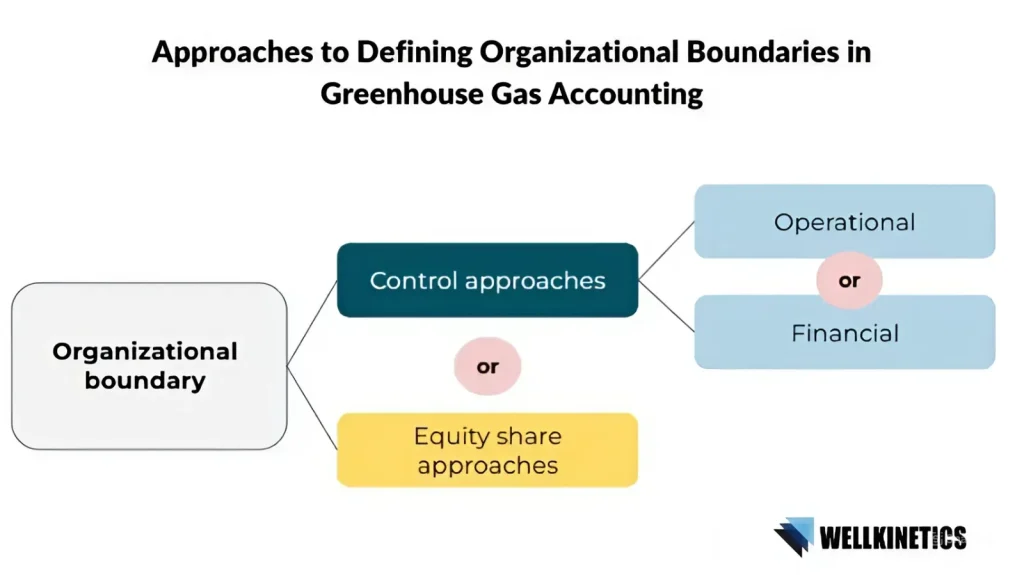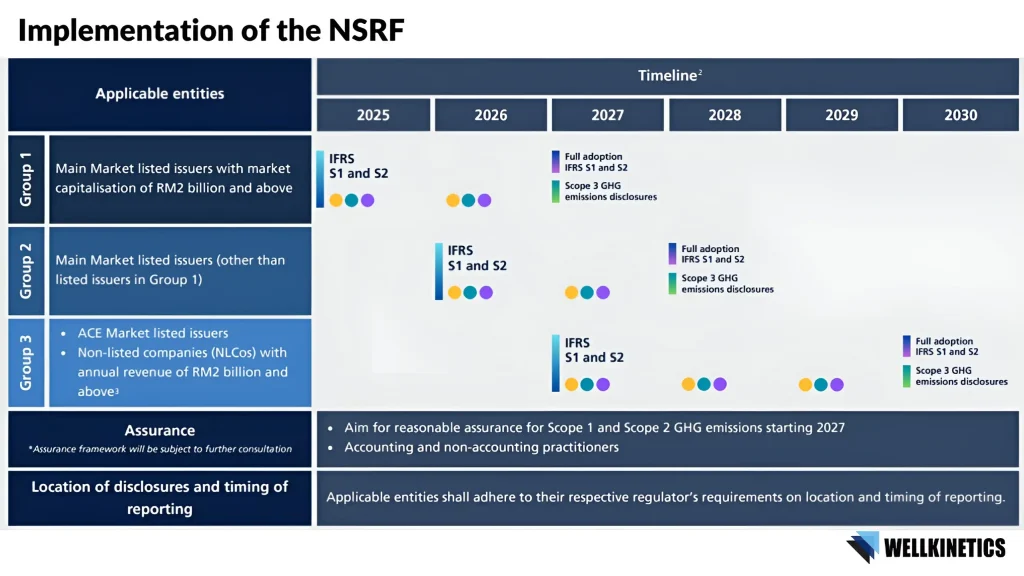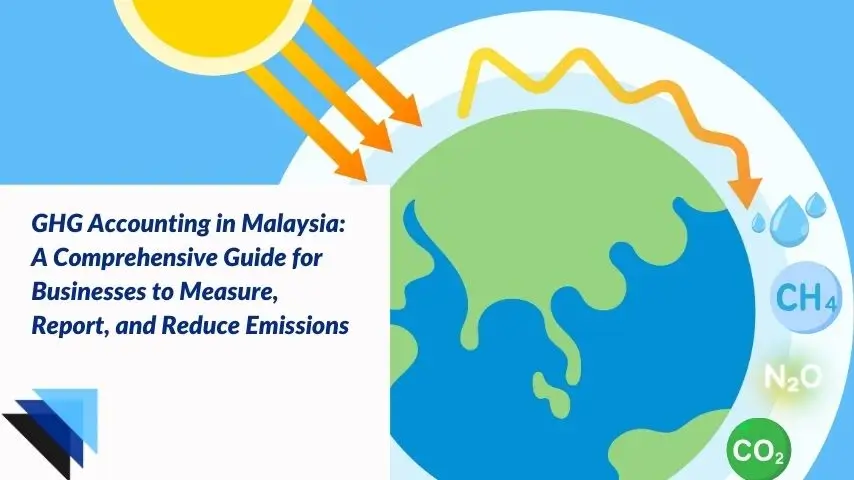Greenhouse Gas (GHG) accounting is a systematic approach to measuring, managing, and reporting greenhouse gas emissions generated by an organization’s activities. This process involves identifying sources of emissions, quantifying the volume of gases released into the atmosphere, and tracking these emissions over time. GHG accounting typically follows internationally recognized standards, such as the Greenhouse Gas Protocol or ISO 14064, which provide guidelines for consistent and transparent reporting.
Looking to understand GHG accounting in Malaysia but feeling overwhelmed by technical complexities involved? The comprehensive measurement and reporting of greenhouse gas emissions has become crucial for Malaysian businesses, with GHG accounting serving as the foundation for effective climate action.
The best approach to GHG accounting in Malaysia involves following the internationally recognized frameworks like the GHG Protocol Corporate Standard, which provides a structured framework for measuring, reporting, and reducing emissions across three key scopes.
In this expert guide, we’ll walk you through:
- Essential GHG accounting protocols and methodologies
- Step-by-step process for measuring different emission scopes
- Practical strategies for emission reduction
- Malaysian regulatory requirements and reporting standards
Whether you’re just starting your sustainability journey or looking to enhance your existing practices, this guide will help you master GHG accounting and drive meaningful environmental impact.
Start Your GHG Accounting the Right Way
Comply with Malaysia’s climate goals and reduce your carbon footprint.
- What are greenhouse gases, and how do they contribute to climate change?
- What is GHG accounting and why is it essential for managing carbon emissions?
- What Are the Key Steps in GHG Accounting?
- What are the key emission reduction strategies organizations can implement to minimize greenhouse gas emissions?
- What is the Malaysian regulatory framework for addressing greenhouse gas emissions and climate change?
- How can organizations manage risks associated with greenhouse gas emissions?
- How Wellkinetics Can Help
What are greenhouse gases, and how do they contribute to climate change?
Greenhouse gases are atmospheric gases that trap heat and contribute to global warming. These gases form a protective layer around Earth, preventing heat from escaping into space. While this natural greenhouse effect is essential for life on Earth, excessive emissions have led to unprecedented climate change challenges.
What are the main types of greenhouse gases and how do they differ in their impact on climate change?
The primary GHG emissions that impact our atmosphere include several key gases, each with distinct characteristics and sources:
1. Carbon dioxide (CO2): Carbon dioxide is the most prevalent greenhouse gas, primarily released through burning fossil fuels, deforestation, and industrial processes. It remains in the atmosphere for hundreds of years, making it a critical focus for emission reduction efforts.
2. Methane (CH4): Methane, though present in smaller quantities than carbon dioxide, is significantly more potent at trapping heat. It’s mainly produced through agricultural activities, waste management, and natural gas extraction.
3. Nitrous oxide (N2O): Nitrous oxide, commonly released through agricultural practices and industrial activities, has a warming potential 298 times greater than CO2. This makes it a particularly concerning greenhouse gas despite its lower concentration in the atmosphere.
4. Fluorinated gases: Fluorinated gases, while artificial and present in small quantities, are the most potent and longest-lasting type of greenhouse gases. These are primarily used in refrigeration and industrial processes.
5. Water vapor: Water vapor, though not directly emitted through human activities, acts as a feedback mechanism in the climate system. As the atmosphere warms due to other GHG emissions, it holds more water vapor, further amplifying the greenhouse effect.
What is GHG accounting and why is it essential for managing carbon emissions?
GHG accounting, also known as carbon accounting, forms the backbone of measuring and managing greenhouse gas emissions. It provides organizations with a structured approach to quantify their environmental impact and make informed decisions about emission reduction strategies.
GHG accounting involves calculating the volume of carbon dioxide (CO2) and other greenhouse gases such as methane (CH4), nitrous oxide (N2O), and fluorinated gases released into the atmosphere as a result of specific activities.

[Image source: GHG Protocol]
The most widely recognized framework for GHG accounting is the Greenhouse Gas Protocol, which categorizes emissions into three scopes:
Scope 1: Direct emissions from sources owned or controlled by the organization, such as company vehicles, on-site fuel combustion, and manufacturing processes.
Scope 2: Indirect emissions from purchased electricity, steam, heating, and cooling consumed by the organization.
Scope 3: All other indirect emissions that occur in a company’s value chain, including purchased goods and services, business travel, employee commuting, waste disposal, use of sold products, and investments.
What Are the Core Principles of GHG Accounting?
Effective GHG accounting adheres to several fundamental principles:
- Relevance: Ensuring the accounting methodology reflects the organization’s emission sources
- Completeness: Including all significant emission sources within defined boundaries
- Consistency: Using uniform methods to enable meaningful comparisons over time
- Transparency: Maintaining clear documentation of processes and assumptions
- Accuracy: Striving for precise measurements while acknowledging uncertainties
Want to Know Your Carbon Footprint?
We’ll assess your emissions and guide you through next steps.
What Are the Key Steps in GHG Accounting?
The key steps in GHG accounting typically include:
Step 1: Defining Organizational and Operational Boundaries in GHG Accounting
Organizational Boundaries in Greenhouse Gas Accounting
The first critical decision in GHG accounting is determining which parts of your organization to include in your emissions inventory. This boundary-setting establishes the foundation for all subsequent accounting activities. You have several recognized approaches to choose from:

Using the operational control method, you include emissions from operations where your organization has the authority to implement operational policies. This pragmatic approach focuses on emissions from activities you can directly manage and improve.
With the financial control approach, you include emissions from entities where your organization has the ability to direct financial and operating policies to gain economic benefits. This approach recognizes that financial responsibility often correlates with the ability to influence emission reduction strategies.
Under the equity share approach, you account for GHG emissions according to your organization’s share of equity in each operation. This method aligns environmental impact with financial interest, creating consistency between financial and environmental reporting.
Operational Boundaries in Greenhouse Gas Accounting
Once organizational boundaries are established, you must identify which emission sources to include across the three recognized scopes:
Scope 1, also known as direct emissions, encompass all greenhouse gases released directly from sources owned or controlled by an organization. These emissions form a significant portion of a company’s total emission footprint and require careful monitoring and reporting.
The primary sources of Scope 1 emissions include stationary fuel combustion from equipment like boilers, furnaces, and generators. Mobile combustion from company-owned vehicles and machinery also contributes significantly to direct emissions. Process emissions from manufacturing operations and fugitive emissions from refrigeration or air conditioning systems are equally important components of corporate GHG accounting.
Indirect emissions are categorized into two distinct scopes – Scope 2 and Scope 3.
Scope 2 covers indirect emissions resulting from electric energy purchase and consumption of purchased heating or cooling. These emissions, though not directly produced by the company, are still considered part of their carbon footprint as they occur due to the organization’s energy consumption patterns.
When your organization buys electricity, steam, heating, or cooling, you’re responsible for the emissions generated during their production, even though they occur at facilities owned by others. These emissions represent a significant portion of many organizations’ carbon footprints.
Scope 3 emissions encompass all other indirect emissions that occur in a company’s value chain. This includes upstream activities like purchased goods and services, employee commuting, and business travel. Downstream activities such as the use of sold products, end-of-life treatment of products, and investments also fall under Scope 3 emissions. While often challenging to quantify, Scope 3 emissions frequently represent the largest portion of an organization’s total climate impact.
Step 2: Collecting Activity Data for Accurate GHG Accounting
Successful GHG accounting begins with comprehensive data collection strategies. Your GHG inventory will incorporate various forms of activity data, each requiring appropriate collection methods. Fuel usage recorded in liters, cubic meters, or tonnes serves as the primary input for calculating many Scope 1 emissions. Gather this information from fuel purchase records, tank level readings, or vehicle management systems.
Energy consumption measured in kilowatt-hours or gigajoules forms the basis for most Scope 2 emissions calculations. This data typically comes from utility bills or meter readings.
Additional activity data may include raw material consumption, production output quantities, distance traveled for transportation activities, refrigerant purchases and usage records, and process inputs and outputs for manufacturing operations. Each data stream requires appropriate quality controls and documentation.
GHG accounting requires organizations to maintain detailed records of all emission-generating activities.
To ensure data accuracy, companies should:
- Implement automated data collection systems
- Establish regular data verification processes
- Train staff on proper data recording procedures
- Document all calculation methodologies
- Maintain clear audit trails
Step 3: Applying Appropriate Emission Factors for GHG Calculations
Selecting appropriate emission factors transforms your activity data into meaningful GHG emission quantities. Whenever possible, use country-specific emission factors that reflect your local energy mix, production methods, and transportation systems. These provide more accurate results than global or regional averages.
Source your emission factors from recognized authorities such as the Intergovernmental Panel on Climate Change (IPCC), national environmental agencies, or industry associations. Document the source and vintage of all emission factors used in your calculations to ensure transparency.
Update your emission factors periodically to reflect changes in grid intensity, production methods, or technological improvements. Using outdated factors can significantly distort your emissions calculations and potentially undermine reduction claims over time.
Step 4: Calculating Carbon Footprint
With activity data and emission factors in hand, calculate emissions separately for each source and scope. Maintain consistent units throughout your calculations, applying conversion factors where necessary to align different measurement systems.
The fundamental calculation for most GHG emissions follows a simple formula:
GHG Emissions = Activity Data × Emission Factor × Global Warming Potential (GWP).
This approach converts your operational data into standardized carbon dioxide equivalent (CO₂e) values that can be aggregated across different gases and activities.
Different greenhouse gases have varying warming impacts on the atmosphere. Apply appropriate Global Warming Potentials to convert non-CO₂ greenhouse gas emissions to CO₂ equivalent (CO₂e), allowing for meaningful aggregation and comparison.
Carbon dioxide serves as the reference gas with a GWP of 1. Methane has a GWP between 28-36 (depending on the timeframe considered), making it a substantially more potent greenhouse gas. Nitrous oxide carries a GWP of 265-298, while various fluorinated gases range from 1,300 to over 23,500 times more powerful than CO₂ in terms of warming impact.
Account for uncertainty and data gaps through transparent estimation techniques. Where precise data isn’t available, develop reasonable estimates based on similar operations, industry benchmarks, or scaled approaches. Document all calculation methodologies, tools, and software used to ensure reproducibility.
Step 5: Verifying GHG Inventory Results for Accuracy and Credibility
This step involves reviewing and validating the greenhouse gas inventory to ensure accuracy and credibility. Verification can be conducted internally, by the organization’s personnel, or externally, by third-party auditors. This process helps to confirm that the data reported is complete, consistent, and in accordance with recognized standards or protocols, such as the ISO 14064 or the Greenhouse Gas Protocol. Verification enhances the reliability of reported emissions, promotes transparency, and provides stakeholders with confidence in the organization’s sustainability claims.
Internal Verification for GHG Reporting
Before finalizing your GHG inventory, conduct thorough internal verification to ensure accuracy and completeness. Review all calculations for mathematical correctness and consistency with established methodologies. Cross-check input data against source documents to confirm accurate transcription and processing.
Validate the assumptions and methodologies applied throughout your inventory development. Question whether approaches are reasonable and aligned with recognized standards. Compare your results with industry benchmarks or previous reporting periods to identify potential anomalies or errors requiring further investigation.
External Verification or Assurance for GHG Reporting
Consider engaging qualified third-party verifiers to enhance the credibility of your GHG inventory. Independent verification provides stakeholders with confidence in your reported emissions and demonstrates your commitment to transparency.
Assurance can be provided by third-party firms, including audit firms, environmental consultants, or experts in GHG reporting, and is typically follow established assurance standards like ISO 14064, ISAE 3000, and AA1000AS. The process of assurance adds credibility to sustainability claims, ensures transparency, and helps companies comply with regulatory requirements.
When selecting a verification body, ensure that they possess relevant accreditations and experience within your specific industry sector. It’s also important to determine the appropriate level of assurance based on your reporting needs and stakeholder expectations. Limited assurance offers moderate confidence, typically through analytical procedures, while reasonable assurance provides a higher level of confidence, supported by more detailed testing.
Finally, address any findings or material discrepancies identified during the verification process. Use these insights as an opportunity to refine your accounting systems, ensuring continuous improvement and enhancing the quality of future GHG inventories.
Step 6: Reporting Emissions
The final step is to report the emissions in a clear and transparent manner. Emissions reporting typically involves summarizing the results of the GHG accounting process and presenting the data in alignment with recognized reporting standards or frameworks, such as the GHG Protocol or the Carbon Disclosure Project (CDP).
Internal Emissions Reporting
Effective internal communication of your GHG inventory results drives organizational awareness and action. Prepare clear dashboards and reports tailored for management review, highlighting key metrics and trends relevant to business operations.
Present findings to sustainability committees and executive leadership, connecting emissions performance to strategic objectives and risk management. Integrate emissions data into management systems and decision processes to ensure climate considerations inform business planning and investment decisions.
External Emissions Reporting
Determine appropriate reporting frameworks based on your stakeholder needs and industry context. Common frameworks include the Carbon Disclosure Project (CDP), Global Reporting Initiative (GRI), and Task Force on Climate-related Financial Disclosures (TCFD). Each offers structured approaches to presenting your emissions data in standardized formats.
Comply with any mandatory reporting requirements applicable to your organization or operating locations. Many jurisdictions now require specific emissions disclosures, particularly for larger companies or carbon-intensive sectors.
Include comprehensive information about methodologies, boundaries, exclusions, and assumptions in your public reporting. Present data in context with relevant benchmarks and targets to help stakeholders interpret your performance. Disclose your verification status and level of assurance to enhance credibility.
What are the common challenges in GHG accounting implementation and how to overcome them?
Common challenges include data collection complexity, resource constraints, and technical expertise gaps. These issues can hinder the development of a reliable emissions inventory. To overcome them, organizations can provide targeted staff training, adopt standardized accounting protocols, and invest in digital tools to streamline data collection and reporting. Partnering with experienced consultants can also help bridge knowledge gaps and ensure compliance with established frameworks such as the GHG Protocol.
What are the key emission reduction strategies organizations can implement to minimize greenhouse gas emissions?
Emission reduction strategies are comprehensive plans designed to minimize greenhouse gas emissions across various operations and activities within an organization. These strategies can be implemented at multiple levels, from operational efficiencies to innovative technologies. The goal is to not only comply with regulatory requirements but also to enhance corporate sustainability, improve public perception, and contribute to global efforts in combating climate change.
What Are the Key Approaches to Setting Emissions Reduction Targets?
Meaningful emissions reduction begins with setting clear, ambitious targets. Consider several established approaches based on your organizational context and climate ambition.
- Absolute reduction targets: Absolute reduction targets specify a percentage decrease in total emissions by a target year compared to a base year (for example, 30% reduction by 2030 from 2020 levels). These targets directly address your total climate impact regardless of business growth or changes.
- Intensity-based targets: Intensity-based targets focus on emissions efficiency, such as reducing emissions per unit of production or revenue. These targets accommodate business growth while driving operational improvements, though they may not guarantee absolute emission reductions if growth outpaces efficiency gains.
- Science-based targets: Science-based targets align your reduction pathway with global climate goals from the Paris Agreement, typically requiring deeper cuts than conventional approaches. These targets demonstrate your commitment to doing your fair share in limiting global warming to well below 2°C.
- Carbon neutrality or net-zero commitments: Carbon neutrality or net-zero commitments represent the most ambitious approach, requiring you to balance any remaining emissions with certified carbon removals after maximizing direct reductions. These comprehensive commitments address your entire carbon footprint across all scopes.
ALSO READ: Sustainability Frameworks: A Guide to Global Standards and Their Application in Malaysia
What Are the Key Steps in the Target Development Process for Emissions Reduction?
Key steps in the target development process for emissions reduction include:
- Establish a reliable base year with complete and verified data as your starting point for measuring progress. This foundation year should represent normal operations and have sufficient data quality to serve as a meaningful reference.
- Analyze reduction potential across different emission sources through technical assessments, benchmarking, and engagement with operational teams. This analysis reveals where meaningful reductions are achievable and helps prioritize investments.
- Consider business growth projections and operational changes when forecasting future emissions and setting targets. Ensure your reduction goals remain ambitious yet achievable given your organization’s strategic direction and market context.
- Define short, medium, and long-term targets to create a balanced reduction pathway. Short-term milestones provide immediate focus, while long-term goals align with global climate imperatives such as achieving net-zero by mid-century.
- Secure leadership commitment and resource allocation to ensure your targets receive the organizational support needed for successful implementation. This includes both financial resources for reduction initiatives and management attention to drive accountability.
How Do You Effectively Track Performance for Emissions Reduction?
Ongoing performance tracking is critical to maintain momentum and measure success. A strong performance monitoring system should include:
- Implement regular monitoring procedures to track progress toward your emission reduction goals. Depending on your organization’s needs, this may involve monthly, quarterly, or annual assessment cycles aligned with broader business reporting.
- Track key performance indicators related to emissions and energy use across your operations. These indicators might include absolute emissions by scope, emissions intensity metrics, energy efficiency ratios, or renewable energy percentages.
- Compare actual performance against targets and benchmarks to identify areas of success and concern. This continuous assessment allows for timely intervention when progress falls short of expectations or when new opportunities emerge.
Reducing GHG emissions is no longer optional, it’s a strategic imperative. Whether you are beginning your sustainability journey or advancing toward net-zero, a well-designed and continuously evaluated emissions strategy enables you to reduce risk, unlock efficiency, and demonstrate leadership in climate action.
What is the Malaysian regulatory framework for addressing greenhouse gas emissions and climate change?
The Malaysian government has established a specific regulatory framework to address greenhouse gas emissions and climate change. This framework is anchored by the National Policy on Climate Change (NPCC), first established in 2009 and updated in 2022, and the Environmental Quality Act 1974 (with relevant amendments). The Ministry of Environment and Water (KASA) and the Department of Environment (DOE) serve as the primary oversight bodies for climate-related regulations and emissions reporting.
What are the compliance requirements for GHG emissions reporting in Malaysia?
In Malaysia, the compliance requirements for GHG emissions reporting are evolving, particularly as the country moves toward achieving its Net Zero GHG emissions target by 2050. Publicly listed companies in Malaysia have been required to disclose their greenhouse gas (GHG) emissions under the Bursa Malaysia Sustainability Reporting Framework since 2023. This requirement mandates the inclusion of a Sustainability Statement in annual reports, aligning with global standards such as the Task Force on Climate-related Financial Disclosures (TCFD).

The National Sustainability Reporting Framework (NSRF), launched in 2024, introduces a phased approach to enhance sustainability disclosures. This framework includes GHG emissions as part of the climate-related disclosures that companies must report. Starting in 2025, large Main Market-listed companies with a market capitalization of RM2 billion and above are required to comply with the NSRF, including detailed climate-related disclosures. Subsequent phases extend these requirements to other listed companies and large non-listed firms by 2027.
As part of this framework, companies will also be required to seek external assurance for their sustainability reports, including the GHG emissions data, to ensure the accuracy and reliability of the information disclosed. This requirement will expand in phases, with additional companies and non-listed firms expected to comply by 2027.
How does GHG accounting align with Malaysia’s national climate commitments?
GHG accounting supports Malaysia’s commitment to reduce greenhouse gas emissions intensity by 45% by 2030 relative to 2005 GDP levels, as outlined in Malaysia’s Nationally Determined Contribution (NDC) under the Paris Agreement. Additionally, in September 2021, Malaysia announced its aspiration to achieve carbon neutrality by 2050. The 12th Malaysia Plan (2021-2025) further reinforces these commitments by establishing a low-carbon nation as one of its key themes, emphasizing the government’s dedication to addressing climate change while ensuring sustainable economic growth.
How can small businesses in Malaysia start their GHG accounting journey?
Small businesses in Malaysia looking to begin their GHG accounting journey can start by conducting a basic carbon footprinting exercise. This involves identifying key sources of emissions such as electricity consumption, transportation, waste management, and business operations. By calculating emissions from these areas, businesses can get an initial understanding of their carbon impact.
To make this process easier, small businesses can utilize free online carbon calculators. These tools require businesses to input simple data, such as energy usage or travel distances, to estimate their carbon footprint. Examples of these free tools include the GHG Protocol’s carbon calculators and other online resources tailored for different industries.
Additionally, small businesses can seek guidance from environmental consultants. Consultants can provide professional advice on improving energy efficiency, tracking emissions, and identifying opportunities for reducing carbon impact. They can also assist in ensuring compliance with reporting standards if businesses plan to disclose their emissions or align with future regulatory frameworks.
As the business progresses, it can gradually expand its accounting scope to include more complex areas, such as Scope 3 emissions from the supply chain, or by tracking energy efficiency improvements and adopting renewable energy sources. This helps businesses progressively reduce their emissions and align with sustainability goals.
Finally, setting targets for emission reductions and monitoring progress regularly will help businesses stay on track. This ongoing process will not only improve their environmental performance but also prepare them for potential future regulations under frameworks like the National Sustainability Reporting Framework (NSRF).
What is a Carbon Credit and How can Malaysian businesses effectively manage carbon credits to contribute to global sustainability goals?
A carbon credit is a permit that allows an organization to emit a specific amount of greenhouse gases, typically measured in metric tons of carbon dioxide or its equivalent in other GHGs. For every ton of carbon dioxide emitted, one carbon credit is issued. These credits are part of a cap-and-trade system where organizations can buy, sell, or trade credits to meet their emissions reduction targets.
In today’s rapidly evolving net-zero emissions movement, businesses in Malaysia are increasingly focusing on strategic approaches to manage their carbon emission footprint. Carbon credit management has emerged as a crucial tool for organizations striving to reduce their own carbon emission while contributing to global sustainability goals.
Carbon credit management involves a systematic approach to buying, selling, and trading carbon credits. These credits represent a verified reduction in greenhouse gas emissions, typically equivalent to one metric ton of carbon dioxide. Companies can purchase these credits to offset their emissions when direct reduction isn’t immediately feasible.
For Malaysian businesses, effective carbon credit management involves:
- Regular assessment of emission levels
- Setting realistic reduction targets
- Identifying potential carbon credit opportunities
- Developing a balanced portfolio of carbon credits
- Monitoring market trends and prices
Organizations can participate in various carbon credit programs:
- Malaysia’s Voluntary Carbon Market (VCM)
- Clean Development Mechanism (CDM)
- Joint Credit Mechanism (JCM)
- Regional Greenhouse Gas Initiative (RGGI)
To maximize the benefits of carbon credit management, companies should:
- Establish clear carbon reduction goals
- Develop a comprehensive carbon credit strategy
- Implement robust tracking systems
- Ensure compliance with international standards
- Regularly review and adjust strategies
By integrating carbon credit management into their overall sustainability strategy, Malaysian businesses can effectively balance their environmental responsibilities while maintaining operational efficiency and contributing to the global fight against climate change.
Stay Compliant, Avoid Costly Penalties
Ensure Compliance with Malaysia’s GHG Reporting Requirements.
How can organizations manage risks associated with greenhouse gas emissions?
Risk management in the context of greenhouse gas (GHG) emissions encompasses the identification, assessment, and prioritization of risks associated with climate change and environmental regulations. Organizations must proactively evaluate potential threats to their operations stemming from regulatory shifts, market dynamics, and physical climate impacts. Effective risk management involves developing strategies to mitigate these risks, ensuring organizational resilience and compliance with evolving sustainability standards.
What are the industry best practices for managing GHG emissions risks and ensuring regulatory compliance in Malaysia?
In today’s rapidly evolving business landscape, effective risk management strategies are crucial for organizations dealing with GHG emissions. As a risk manager, it’s essential to understand and implement industry-leading practices to address both current and emerging challenges.
Climate change presents significant transition risk for businesses across Malaysia. Companies must develop robust frameworks to identify, assess, and mitigate these risks effectively. This includes monitoring regulatory changes, market shifts, and technological advancements that could impact their operations.
Organizations should establish comprehensive risk assessment protocols that consider the full range of human activity within their operations. This involves:
- Regular environmental impact assessments
- Scenario planning for climate-related risks
- Integration of sustainability metrics into decision-making processes
- Development of adaptation strategies
- Implementation of early warning systems
Forward-thinking companies are increasingly adopting advanced technologies and data analytics to enhance their risk management capabilities. These tools help organizations:
- Monitor real-time emissions data
- Predict potential environmental impacts
- Identify opportunities for emissions reduction
- Track compliance with regulatory requirements
- Generate accurate sustainability reports
The future of GHG accounting in Malaysia points toward more stringent regulations and increased stakeholder scrutiny. Organizations must stay ahead of these trends by:
- Investing in sustainable technologies
- Building internal capacity for emissions management
- Engaging with industry peers and experts
- Participating in sustainability initiatives
- Maintaining transparent communication with stakeholders
How Wellkinetics Can Help
At Wellkinetics, we understand the complexities and challenges that Malaysian businesses face in managing their carbon emissions and navigating the regulatory landscape associated with greenhouse gas (GHG) emissions. Our comprehensive solutions are designed to empower organizations in their sustainability journey while ensuring compliance and facilitating effective carbon credit management.
Our Expertise:
1. Tailored Carbon Footprint Analysis
We start with a detailed analysis of your company’s carbon footprint, identifying key emission sources and compliance gaps. This foundational step enables us to create a customized action plan tailored to your specific needs and objectives.
2. Compliance Readiness and Reporting Support
In the face of increasing regulatory scrutiny, Wellkinetics provides comprehensive compliance readiness services. Our team ensures that your organization is equipped to meet current and future regulatory requirements, with assistance in preparing thorough and credible sustainability reports that highlight your environmental performance.
3. Advanced Risk Management Frameworks
Our experienced team works with clients to develop advanced risk management frameworks that proactively address climate-related risks. This includes comprehensive training on scenario planning, risk assessment protocols, and strategies to adapt to a shifting regulatory environment.
4. Stakeholder Engagement and Communication
Effective engagement with stakeholders is vital to the success of any sustainability strategy. At Wellkinetics, we assist businesses in crafting clear and transparent communication strategies that articulate your carbon management efforts and sustainability commitments. Whether you’re addressing employees, investors, customers, or regulatory bodies, we help you convey your message in a compelling and relatable manner.
5. Continuous Improvement and Monitoring
Sustainability is an ongoing journey, and constant evaluation is key. We support organizations in establishing frameworks for regular monitoring and assessment of their sustainability initiatives. Our methodologies encourage continuous improvement, allowing you to adapt and evolve your strategies based on changing conditions and emerging best practices.
6. Target Setting and Decarbonization Plan
We help businesses set clear KPI and targets for emission reductions and sustainability goals, providing a measurable and actionable roadmap. Our decarbonization plans are designed to guide your organization towards achieving these targets through effective strategies, technological solutions, and continuous monitoring to track progress and ensure success in reducing your carbon footprint.
7. Energy Management Review (EMR)
We offer a comprehensive Energy Management Review (EMR) to evaluate your current energy management and monitoring program. Our team assesses the KPIs, energy mix, and the structure of your energy drivers to identify areas for optimization. Based on our findings, we provide a detailed recommendation for an energy management improvement plan that includes strategic focus areas and practical inception tactics. This ensures that your organization enhances energy efficiency, reduces costs, and aligns with sustainability objectives.
Learn more about our ESG consulting and environmental consulting services.




